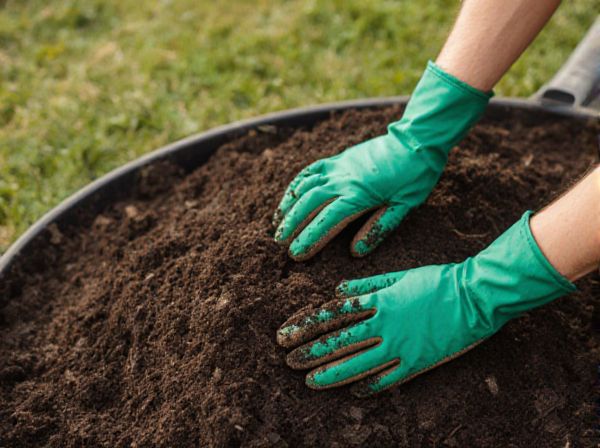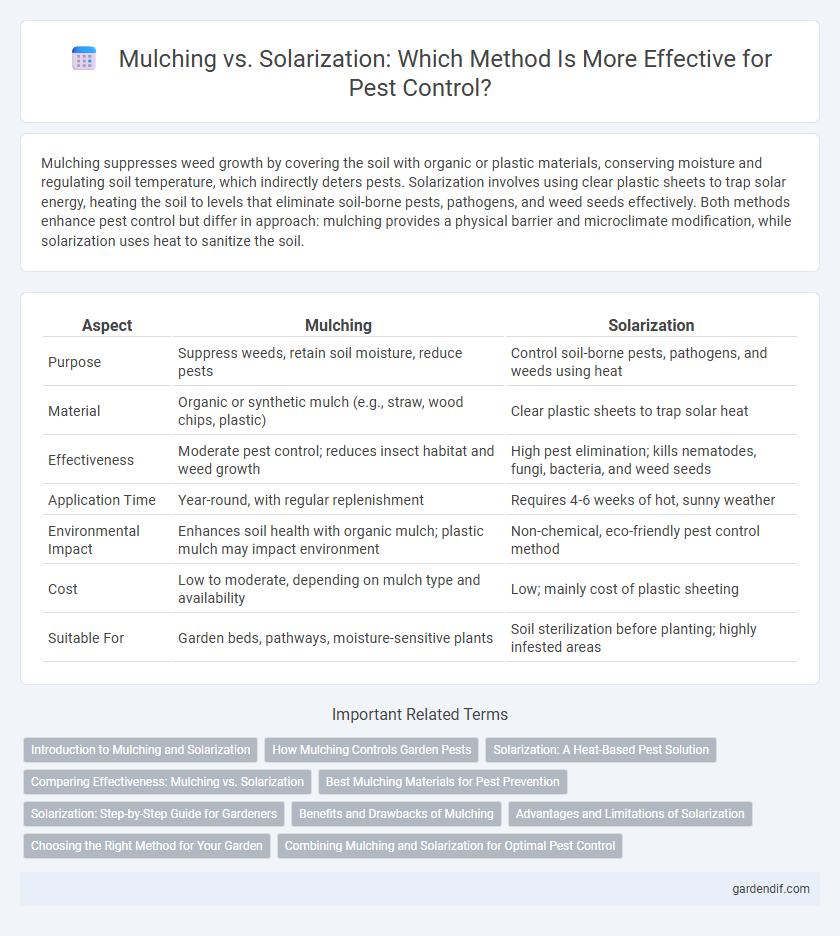
Mulching vs Solarization Illustration
Mulching suppresses weed growth by covering the soil with organic or plastic materials, conserving moisture and regulating soil temperature, which indirectly deters pests. Solarization involves using clear plastic sheets to trap solar energy, heating the soil to levels that eliminate soil-borne pests, pathogens, and weed seeds effectively. Both methods enhance pest control but differ in approach: mulching provides a physical barrier and microclimate modification, while solarization uses heat to sanitize the soil.
Table of Comparison
| Aspect | Mulching | Solarization |
|---|---|---|
| Purpose | Suppress weeds, retain soil moisture, reduce pests | Control soil-borne pests, pathogens, and weeds using heat |
| Material | Organic or synthetic mulch (e.g., straw, wood chips, plastic) | Clear plastic sheets to trap solar heat |
| Effectiveness | Moderate pest control; reduces insect habitat and weed growth | High pest elimination; kills nematodes, fungi, bacteria, and weed seeds |
| Application Time | Year-round, with regular replenishment | Requires 4-6 weeks of hot, sunny weather |
| Environmental Impact | Enhances soil health with organic mulch; plastic mulch may impact environment | Non-chemical, eco-friendly pest control method |
| Cost | Low to moderate, depending on mulch type and availability | Low; mainly cost of plastic sheeting |
| Suitable For | Garden beds, pathways, moisture-sensitive plants | Soil sterilization before planting; highly infested areas |
Introduction to Mulching and Solarization
Mulching involves covering the soil with organic or inorganic materials to suppress weeds, retain moisture, and improve soil health, effectively reducing pest habitats. Solarization uses transparent plastic sheets to trap solar energy, raising soil temperature to levels that kill soil-borne pests, pathogens, and weed seeds. Both techniques offer eco-friendly pest control methods that enhance soil quality and promote sustainable gardening.
How Mulching Controls Garden Pests
Mulching controls garden pests by creating a physical barrier that deters insects and disrupts their habitat, reducing egg-laying and larval development. Organic mulches, such as straw or wood chips, foster beneficial predatory insects and microorganisms that naturally suppress pest populations. This method also maintains soil moisture and temperature, creating an unfavorable environment for pests while promoting healthy plant growth.
Solarization: A Heat-Based Pest Solution
Solarization uses solar energy to raise soil temperatures to levels lethal for many pests, pathogens, and weed seeds, typically between 113degF and 140degF (45degC to 60degC) for 4 to 6 weeks. This eco-friendly method reduces dependence on chemical pesticides while improving soil health by increasing nutrient availability and microbial activity. Effective in warm, sunny climates, solarization targets soil-borne diseases and nematodes, providing sustainable pest control for vegetable gardens and crop fields.
Comparing Effectiveness: Mulching vs. Solarization
Mulching effectively suppresses weeds by blocking sunlight and maintaining soil moisture, which indirectly reduces pest habitats, while solarization uses clear plastic covers to trap solar energy, raising soil temperatures to levels that kill soil-borne pests, pathogens, and weed seeds directly. Solarization generally provides a more intensive and lethal treatment for soil pests, achieving temperatures above 45degC (113degF) for several weeks, whereas mulching offers longer-term soil health benefits but less immediate pest mortality. Both methods improve pest management but differ in intensity, with solarization excelling in pest eradication and mulching enhancing environmental conditions that limit pest survival.
Best Mulching Materials for Pest Prevention
Organic mulches such as cedar chips, pine needles, and straw effectively repel pests by creating a physical barrier and releasing natural insect-repellent compounds. Cedar mulch contains natural oils that deter insects like ants and termites, while pine needles acidify the soil, discouraging certain pests. Straw mulch improves soil health and moisture retention, indirectly reducing pest infestations by promoting robust plant growth.
Solarization: Step-by-Step Guide for Gardeners
Solarization harnesses solar energy by covering moist soil with clear plastic sheets, heating the ground to eliminate pests, weeds, and pathogens effectively. To solarize, start by thoroughly watering the soil, then lay transparent plastic securely, ensuring edges are buried to trap heat. Maintain the plastic in place for 4 to 6 weeks during the hottest part of the year for optimal pest control in garden beds.
Benefits and Drawbacks of Mulching
Mulching enhances soil moisture retention, suppresses weed growth, and improves soil structure, making it an effective method for pest control in gardens and agricultural fields. However, mulching can create a habitat for certain pests such as slugs and rodents if not managed properly, and it may also contribute to fungal diseases if excessive moisture is retained. Selecting appropriate mulch materials like straw or wood chips and monitoring moisture levels are essential to maximize benefits and minimize drawbacks.
Advantages and Limitations of Solarization
Solarization uses solar energy to heat soil, effectively reducing pest populations, weed seeds, and soil-borne pathogens without chemicals, promoting an eco-friendly pest control method. Its advantages include enhancing soil nutrient availability, suppressing nematodes, and improving crop yield, especially in warm, sunny climates with high solar radiation. Limitations involve reduced effectiveness in cooler or cloudy regions, the requirement for several weeks of soil coverage with clear plastic, and inability to control deep soil pests or those resistant to heat.
Choosing the Right Method for Your Garden
Mulching and solarization both effectively manage garden pests by creating unfavorable conditions for harmful insects and pathogens. Mulching improves soil moisture retention and suppresses weeds, while solarization uses solar heat to kill pests and soil-borne diseases more intensively. Selecting the right method depends on your garden's climate, pest severity, and crop sensitivity to ensure optimal pest control and soil health.
Combining Mulching and Solarization for Optimal Pest Control
Combining mulching and solarization enhances pest control by using organic mulch to retain soil moisture and heat while solarization involves covering moist soil with clear plastic to trap solar energy, effectively killing pests and pathogens. This integrated approach improves soil health, suppresses weeds, and reduces reliance on chemical pesticides, boosting crop yield. Studies show that combining these methods accelerates temperature rise in the soil, resulting in more effective elimination of soil-borne pests compared to using either technique alone.
Mulching vs Solarization Infographic

 gardendif.com
gardendif.com